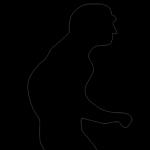Design thinking in business. Tim Brown - Design Thinking in Business: From New Product Development to Business Model Design
Tim Brown's book Design Thinking in Business. From developing new products to designing business models.” Original Change by Design: How Design Thinking Transforms Organizations and Inspires Innovation
The first couple of chapters seemed to me mortal boredom. Somewhere from the 4th chapter it became interesting. I noticed that the author uses the word "innovation" too often in the book. Like a book about Skolkovo. Every time I came across this word, I remembered Fry from Futurama when he was drinking coffee. 
The book is a collection of stories about how design thinking has helped IDEO (Tim Brown its director) for decades. How to “turn on” design thinking, however, did not become clear. Is not practical guide more of a narrative discussion. Like Victor Papanek's book Design for the Real World. If you have read Papanek and liked his work, you will also like Brown's book. She's talking about something similar. The author tells how they used design thinking in a particular project. In the end, it seems like a magic pill: “Is there a problem in business, family, life? Design thinking will help you.” But in fact, you can say that your brain will just help you. Think, observe, empathize, and design. At the same time, it is unlikely that after reading the book in your head it will click: “Aha! I understand. I will do this, then this, and everything will be cool with me. ”
Here is one of the stories. The designers were challenged by Shimano, which makes various bicycle equipment, to do something with falling demand. It seemed to release a new innovative body kit and get an explosion in sales. It turned out that buyers do not need more speed, and not nano-alloy parts. Almost every second person has a mountain bike in the garage. Only it is not ridden: it is inconvenient to maintain it, it is too complicated, the city is not intended for cycling. Someone does not want to pass for a layman in a store when buying a heaped bike. People needed a simple touring bike. To drive it around the park and rejoice, as in childhood.
[…] Designers could have finished the project on the bike itself, but holistic design thinkers have gone further. They developed sales strategies for small shops, in part, to reduce the discomfort experienced by newcomers in an environment designed to cater to bike-savvy people. The team came up with a brand that defines recreational riding as one of the ways to enjoy life. In collaboration with local authorities and cycling clubs, the team developed a PR campaign, even created a website indicating safe places to ride.
I also liked the example about finances:
Bank of America launched a new service in October 2005 called No Change. This service automatically rounds debit card purchases to the nearest whole dollar and credits the difference to the customer's savings account. Now, when I buy a $3.50 coffee from Pete's with my debit card, the 50 cents I would have received in change if I handed the cashier $4 are sent to my savings account. Considering how much coffee I drink, the savings in my account are growing fast. And I'm not the only one who considers this method a good way to save money. In its first year, the service attracted 2.5 million customers who opened more than 700,000 new checking accounts and 1 million new savings accounts. It would hardly be possible to achieve such results by asking people to change their behavior, giving boring lessons about compound interest, or lecturing on the true value of money. By fitting the new service into existing behavior, IDEO has provided customers with something that is both familiar and compellingly new. Without even realizing it, Bank of America clients began to achieve results that they had never achieved and that they hardly thought were possible.
I want people to grow up not only to open savings accounts with the help of banking services, but also begin to understand finances, become more conscious in managing their money. To do this, we are in Tradernet and started a blog. In the meantime, on payday, you can see queues at ATMs when people withdraw all their money in cash because they don’t trust cards: “It’s safer at home!”
The book is full of stories. Sometimes there are less convincing examples. For example, when the author talks about how Nokia made the decision to move away from simple production phones to create a highly interactive business with a focus on services. It was 2006, the book came out in 2009, and the iPhone in 2007. Something is wrong here.
About prototyping
An agile team of design thinkers starts prototyping from the beginning and fixes bugs along the way. As we say at IDEO: "Make mistakes early to ultimately succeed."
The sooner you make an idea tangible, the sooner you can evaluate it, refine it, and come to a final decision.
And one more word in support of rapid prototyping:
The more you invest in an idea, the more you become a supporter of it. Over-investing in a sophisticated prototype has two undesirable consequences: first, a mediocre idea can go too far along the path to implementation, and in the worst case, can be implemented; secondly, the prototyping process itself opens up opportunities to explore new and better ideas at minimal cost.
The more complex and expensive a prototype is, the more “finished” it looks, and the less likely its creators are to get valuable design information—and less likely to take it into account. The purpose of prototyping is not to create a working model.
About restrictions
Joyful, enthusiastic acceptance of constraints is the foundation of design thinking. The first stage of design is to find important constraints and determine the system for their evaluation. Constraints are best visualized as three arguing criteria for successful ideas: feasibility (what is functionally possible for the foreseeable future), cost-effectiveness (which is likely to become part of a sustainable business model), and desirability (what people and for people want).
While this may seem obvious, the reality is that most companies approach new ideas differently. Quite sensibly, they start with limitations on what goes into the structure. existing business model. Because business systems are designed to achieve maximum efficiency, new ideas tend to be incremental in nature, predictable, and easily copied by competitors. This explains the depressing monotony of products on modern markets; did it not happen that you went to the department household appliances looking for a printer or almost getting into someone else's car in the parking lot?
About the role of designers
The next generation of designers should be just as comfortable on boards as they are in studios or workshops. And these people will also need to treat every issue, from adult literacy to global warming, as a design issue.
The job of a designer, as Peter Drucker aptly put it, is to "turn need into demand." At first glance, everything is simple: you need to understand what people want - and give it to them. But if it's so easy, why are there so few success stories like the iPod, Prius, MTV or eBay? The answer, I think, is to bring the person back to center stage. You have to learn to look at people first.
Why is it so difficult to define a need and design a response to it? The main problem is that people are so good at adapting to uncomfortable situations that they often don't even notice it: they sit on seat belts, write PIN codes on their palms, hang jackets on doorknobs, and strap bicycles to park benches.
Three interrelated and mutually reinforcing elements of any successful design program:
- Insight - learning from the lives of others.
- Observation - we look at what people do not do, listen to what they do not say
- Empathy - we put ourselves in the place (or lie down on a gurney) of other people.
About observation
Simply asking people to talk about how they spend their time at work and who they regularly interact with can lead to distorted information. Even if a person has the best intentions, his memory may fail him, and the answers will most likely reflect his ideas of hard facts. Tools like video ethnography (where the behavior of a group is recorded on camera over a period of time) and computer interaction analysis help provide more accurate data on the dynamic interactions between individuals and groups.
Good design thinkers observe. Great design thinkers watch the ordinary. Enter a rule for yourself: at least once a day, stop and think about the most ordinary situation.
About the knowledge base
The author quotes Linus Pauling, Nobel laureate: “To find good idea First of all, you need a lot of ideas.” Therefore, IDEO designers collect a large knowledge base, look at solving different problems, generate many ideas in order to find the right one. It is prepared on the basis of others.
About ideas
A good idea is no longer enough. Innovation is called "a good idea implemented well". Not a bad start. Unfortunately, too much attention is paid to the first part of this phrase.
New products and services can be doomed to failure for a variety of reasons: poor quality, uninteresting marketing, unreliable distribution, unrealistic pricing. Even if all the success factors are in place, a poorly implemented idea is likely to lead to failure. The problem may lie in the physical implementation of the product - it is too big, too heavy, too complex. Similarly, points of interaction with new service- be it a space for retail or interface software- may not be related to customers. These are design flaws and can usually be fixed. Increasingly, however, ideas fail because people demand more from them than simple work. The components of the product should collectively evoke a positive perception. And this is much more difficult.
There are many explanations for this new level of high expectations. Among the most compelling is Daniel Pink's analysis of the psychodynamics of abundance. In A Whole New Mind11, Pink argues that once a person's basic needs are satisfied—and they are for most people in wealthy Western societies—people crave experiences that are meaningful and emotionally satisfying.
About choice
About the benefit for the client
An organization that practices anthropocentric design thinking is actually practicing enlightened selfishness. If a company understands customers better, it can better meet their needs. It is the most reliable source of long-term profitability and sustainable growth. In the business world, every idea - no matter how noble - must be tested by financial results.
When passengers (of an aircraft) understand what is wanted from them and why, they are more tolerant of procedures that otherwise seem meaningless and conditional.
Customer Journey
A simple means of creating a scenario during the development of new services is the "customer journey". Such a structure indicates the stages through which a fictional client passes from the beginning of receiving a service to the end. The beginning may be fictional, or it may come directly from watching people buy an airline ticket or decide whether or not to install rooftop solar panels. In each case, the value of describing the customer journey is that it can help you understand where the customer and service or brand interact. Each of these touchpoints is an opportunity to deliver value to a company's potential customers—or an opportunity to derail customer relationships.
Kostya Soroka told me about this instrument. I want to study in more detail and try in practice in Tradernet. Already made sketches, but so far they seem rough and wrong to me. As I understand it, it is important to describe not just “points of contact” or existing business processes of the company, but to see them from the other side.
How to Apply Design Thinking
- Start from the beginning - you need to intentionally increase the number of options. At the end of a project, it makes no sense, so design thinking needs to be connected at the beginning, even at the stage of research work. Design thinkers must connect all parts of the production and marketing process.
- Take an anthropocentric approach. Design thinking is not just anthropocentric, it is human at its core. Design thinking is based on the ability of a person to intuitive feeling, to recognize patterns, to create ideas that carry not only a functional, but also an emotional component, to express oneself not only in words or symbols.
- Fail early, fail often. Make prototypes.
- Share inspiration. Share knowledge, maintain a knowledge base.
- Carry out the design throughout the cycle.
Tim Brown
Design thinking in business. From new product development to business model design
Published with permission from Tim Brown c/o Fletcher & Company and Andrew Nurnberg Literary Agency
Edited by Irina Kuteneva
All rights reserved.
No part of this book may be reproduced in any form without the written permission of the copyright holders.
Copyright © 2009 Tim Brown
© Translation into Russian, edition in Russian, design. LLC "Mann, Ivanov and Ferber", 2018
* * *Dedicated to Gaynor
Introduction. The power of design thinking
Saying goodbye to old ideasAlmost everyone who has been to England has seen the Great Western Railway, the crowning achievement of the greatest engineer of the Victorian era, Isambard Kingdom Brunel. I grew up very close to this railway, in Oxfordshire. As a child, I often rode my bicycle up to the tracks and waited for the huge express train to roar past at over a hundred miles an hour. Today's trains are more comfortable (they have springs and cushioned seats), and the view outside the train windows has certainly changed, but a century and a half after its construction, the Great Western Railway is still an example of design changing the world.
Although Brunel was an engineer to the marrow of his bones, there is more than just a technical side to his creations. During the design of the railway, he insisted on keeping the embankment as low as possible - he wanted passengers to feel as if they were "floating" through the fields. He built bridges, viaducts, roads and tunnels - and at the same time he thought not only about the efficiency of transport, but also about maximum convenience. He even drafted an integrated transport system, which would allow the traveler to board the train at Paddington station in London and get off the steamer in New York. In each of his projects, Brunel has shown an amazing - and surprisingly perfect - talent for combining technical, commercial and human aspects. He was not just a great engineer or a talented designer. Isambard Kingdom Brunel was one of the first design thinkers.
Since the construction of the Great Western Railway in 1841, industrialization has changed our world in incredible ways. Technology has helped millions overcome poverty and raised the standard of living for most of humanity. However, at the beginning of the twenty-first century, we are increasingly aware of the other side of the revolution, which has changed the way we live, work and play. Black puffs of smoke that once covered the sky over Manchester and Birmingham have changed the planet's climate. The flood of cheap goods produced by their factories and workshops became the basis of a culture of overconsumption and horrendous waste. Industrialization Agriculture made us vulnerable to natural and man-made disasters. Innovative breakthroughs of the past have become everyday life modern world where companies in Shenzhen and Bangalore use the same management theories as companies in Silicon Valley and Detroit - and face the same downward spiral of mercantilization.
The technology has not yet become obsolete. The communications revolution that began with the advent of the Internet has shortened distances and given people a never-before-seen opportunity to exchange views and create new ideas. Biology, chemistry and physics have united in biotechnology and nanotechnology, promising us the emergence of new drugs and amazing materials. However, these incredible achievements are unlikely to help get off the sad path that humanity is moving on. Vice versa.
We need new solutions
A purely technocentric view of innovation today does not provide stability, and a management philosophy based on the choice of old strategies will give way to new developments in our country or abroad. We need new solutions - new products that combine the needs of individuals and the needs of society as a whole; new ideas to address global issues of health, poverty and education; new strategies that lead to changes in the world, new goals that capture people around. It is hard to imagine another time when the problems facing humanity would be so superior to our creative resources to solve them. Passionate innovators brainstorm, learn a few tricks and tricks, but rarely bring new products, services, or strategies to the world.
We need a new approach to innovation - powerful, efficient, widely available, integrable into all aspects of business and society; an approach that individuals and entire teams can use to create breakthrough ideas that can be brought to life and thus change it. Design thinking, the subject of this book, offers just such an approach.
Design thinking begins with the skills that engineers and designers have been trained for decades in their quest to balance human needs and available technical resources within the natural constraints of a business. By integrating what is humanly desirable, technologically feasible, and economically viable, designers were able to create the products we use today. Design thinking takes us one step further by transferring all these tools to people who never considered themselves designers, but who can now apply such tools to a wide range of problems.
Design thinking takes advantage of the possibilities that each person has, but not taken into account in standard problem solving methods. Design thinking is not just anthropocentric, it is human in nature. Design thinking is based on the ability of a person to intuitive feeling, to recognize patterns, to create ideas that carry not only a functional, but also an emotional component, to express oneself not only in words or symbols. Nobody wants to run a company based on feelings, intuition, and inspiration, but over-reliance on rationalism and analytics is just as dangerous. The integrated approach at the heart of design thinking offers us a third way.
Moving Design to the Source of Decision Making
I was trained as an industrial designer, but it took a long time before I realized the difference between what it is to be a designer and what it is to think like a designer. Seven years of study and fifteen years of professional practice passed before I began to understand that I was not just a link in the chain between the design department and the marketing department.
My very first professional developments were products for a well-known equipment manufacturer, Wadkin Bursgreen. The company's management brought in a young and untested designer to help them improve their woodworking machines. I spent a whole summer designing and building better looking circular saws and easier to use spindle machines. I think I did a good job. My products can still be found in factories - and thirty years have passed since then. But Wadkin Bursgreen is no more, it ceased to exist a long time ago. I didn't realize then that the problem was the future of the woodworking industry, not the design of woodworking machines.
It was only gradually that I began to see design not as a chain link, but as a wheel hub. When I left the hothouse world of art school—where everyone looked the same, acted the same, and spoke the same language—and got into the world of business, I had to spend a lot more time explaining what design is than actual design work. I realized that I was looking at the world with operating principles that were different from those of my clients. And the resulting confusion hindered my creativity and productivity.
In addition, I noticed that the people who inspired me were not necessarily from the design profession: they were engineers like Isambard Kingdom Brunel, Thomas Edison and Ferdinand Porsche, who had an anthropocentric, not technocentric view of the world; behavioral scientists like Don Norman, who asked why foods are so unreasonably uniform; artists like Andy Goldsworthy and Anthony Gormley, who seemed to turn the audience into one of the elements of creation; business leaders like Steve Jobs and Akio Morita who created unique, meaningful products. I realized that behind the words "genius" and "visionary" is the use of design thinking principles.
A few years ago, during one of Silicon Valley's booming years of growth, my colleagues and I were trying to figure out how to make sense of my company, IDEO. Many people were interested in our design services, but we also noticed that more and more often we were asked to solve problems that seemed very far from the usual ideas about design. The Medical Foundation approached us with a request to assist in the restructuring of their organization; the management of a hundred-year-old manufacturing company wanted us to help them understand their customers; an elite university turned to us for solutions in the field of alternative educational environments. We were pushed out of our comfort zone, but we liked it, because new opportunities opened up before us, allowing us to change the world.
Design thinking is a way of perceiving the world from leading designers and planners, as well as a research process that allows you to find non-standard solutions for the development of projects. It is built on the ability of a professional to think integratively, on the willingness to perceive design outside of design and to cut across the boundaries of individual disciplines in their work.
Also, design thinking is a model of effective business building, applied not only to people or products, but even to entire companies.
Design thinking in business. Review from App2World
The book Design Thinking in Business describes all the stages, methods and areas of application of design thinking in business, project management and the style of human life.
about the author
Tim Brown is President and CEO of design company IDEO. Yes, the same IDEO, which at one time developed a computer mouse for a radically new computer from Apple at that time. This product was intended for mass use.
Who should read and why
- designers - to gain new knowledge and techniques from the best specialists in the profession;
- managers - to understand how designers work and how a design strategy is developed;
- leaders - to know how design thinking is used by corporations;
- and sympathetic - to develop the ability to come to design solutions.
What is useful in the book
1. You can discover how design thinking is changing our world here and now, creating the most incredible and useful projects for humans.
2. You can get specific knowledge and examples on the methodology of design thinking.
3. You can and should be inspired. Moreover, all the advice in the book is received by the practical way that the IDEO company has gone through.
Design thinking approach
Tim Brown in his book fully described the design thinking methodology and provided it with specific examples from the practice of both his own and many other well-known companies.
Design thinkers are navigating a new economy that focuses on people over technology. By observing a person, you can see their behavior, reactions to products and services, the context of their experience, and identify hidden needs. Only in this way does a demanded product appear that accelerates the progress of mankind.
The power of prototyping
The prototype, according to Tim Brown, is needed in order to make mistakes early and understand in which direction to move on and "ultimately succeed." Planners and designers always follow this line:
Prototyping -> making mistakes -> perfecting the idea.
insight
Helps to get rid of social stereotypes. Illumination is a process available to everyone and completely free of charge. Everything that is around us is able to illuminate and see the solution from a different angle than we are used to.
Observation
We look not only at what people do, but also at what they do not do.
The only way to find out what a grocery store worker needs is to go to his workplace.
empathy
We put ourselves in the place of those people for whom the product is intended.
One of the leading members of the project team, Christian Simsarian, even lay down on a gurney in the emergency room to walk the patient's path from the registration room to the bed and understand what he feels, sees, and touches.
Out-of-focus groups
Interesting things can be seen, focusing not only on the focus group of the target audience, but also on people who are completely unsuitable for it. If we pay attention to the central part of the product audience, we will get the usual results. A non-focus group will help you look at the problem in a completely different way.
Experimentation
The main tool of design thinking. Experimentation gives new data and improves the idea.
Culture of Optimism
Optimism in a team breeds confidence, and confidence breeds trust. The latter feeds both.
visual thinking
It doesn't matter if you can draw or not. The main thing is that you can display the idea graphically, for understanding. Drawing determines solutions.
The Importance of Storytelling
Storytelling in design thinking is the ability to spread ideas by creating stories.
7 good book quotes
About restrictions
“There is no design without limits, and the best design is an accurate medical device or a shelter for victims. natural disasters- is obtained under the most severe restrictions.
"...time is the most creative constraint."
About creativity
“A company doesn't have to be crazy, goofy, and located in Northern California to be creative. What really matters is the environment - both social and spatial - in which people can experiment, take risks, test all their skills in practice.
About related professions
"Design is too important these days to be left to designers."
About brainstorming
“Don't judge. Encourage wild ideas. Don't deviate from the topic."
On the power of prototyping
“The very first and greatest prototype of IDEO was created when the company consisted of eight unkempt designers gathered in a studio above the Roxy clothing store on University Avenue in Palo Alto. Douglas Dayton and Jim Yurchenko attached a roll-on deodorant ball to the base of a plastic oil can. Soon Apple introduced its first computer mouse.
About the most important
“Good design thinkers observe. Great design thinkers observe the ordinary.”
About life design
“Consider life as a prototype. You can experiment, make discoveries, change points of view. You can look for opportunities to turn processes into projects that give tangible results.”
How to read
The book is 6 hours long. Objectively, this is not enough, because in the process the hand reaches out to make notes. Obviously not something that is read in one breath. The book needs reflection.
Dedicated to Gaynor
Introduction
The power of design thinking
Saying goodbye to old ideas
Almost everyone who has been to England has seen the Great Western Railway, the crowning achievement of the greatest engineer of the Victorian era, Isambard Kingdom Brunel. I grew up very close to this railway, in Oxfordshire. As a child, I often rode my bicycle up to the tracks and waited for the huge express train to roar past at over a hundred miles an hour. Today's trains are more comfortable (they have springs and cushioned seats), and the view outside the train windows has certainly changed, but a century and a half after its construction, the Great Western Railway is still an example of design changing the world.
Although Brunel was an engineer to the marrow of his bones, there is more than just a technical side to his creations. During the design of the railway, he insisted on keeping the embankment as low as possible - he wanted passengers to feel as if they were "floating" through the fields. He built bridges, viaducts, roads and tunnels - and at the same time he thought not only about the efficiency of transport, but also about maximum convenience. He even drafted an integrated transportation system that would allow a traveler to board a train at Paddington Station in London and get off a steamboat in New York. In each of his projects, Brunel has shown an amazing - and surprisingly perfect - talent for combining technical, commercial and human aspects. He was not just a great engineer or a talented designer. Isambard Kingdom Brunel was one of the first design thinkers.
Since the construction of the Great Western Railway in 1841, industrialization has changed our world in incredible ways. Technology has helped millions overcome poverty and raised the standard of living for most of humanity. However, at the beginning of the twenty-first century, we are increasingly aware of the other side of the revolution, which has changed the way we live, work and play. Black puffs of smoke that once covered the sky over Manchester and Birmingham have changed the planet's climate. The flood of cheap goods produced by their factories and workshops became the basis of a culture of overconsumption and horrendous waste. The industrialization of agriculture has made us vulnerable to natural and man-made disasters. Innovative breakthroughs of the past have become the daily routine of the modern world, where companies in Shenzhen and Bangalore use the same management theories as companies in Silicon Valley and Detroit - and face the same downward spiral of mercantilization.
The technology has not yet become obsolete. The communications revolution that began with the advent of the Internet has shortened distances and given people a never-before-seen opportunity to exchange views and create new ideas. Biology, chemistry and physics have united in biotechnology and nanotechnology, promising us the emergence of new drugs and amazing materials. However, these incredible achievements are unlikely to help get off the sad path that humanity is moving on. Vice versa.
We need new solutions
A purely technocentric view of innovation today does not provide stability, and a management philosophy based on the choice of old strategies will give way to new developments in our country or abroad. We need new solutions - new products that combine the needs of individuals and the needs of society as a whole; new ideas to address global issues of health, poverty and education; new strategies that lead to changes in the world, new goals that capture people around. It is hard to imagine another time when the problems facing humanity would be so superior to our creative resources to solve them. Passionate innovators brainstorm, learn a few tricks and tricks, but rarely bring new products, services, or strategies to the world.
We need a new approach to innovation - powerful, efficient, widely available, integrable into all aspects of business and society; an approach that individuals and entire teams can use to create breakthrough ideas that can be brought to life and thus change it. Design thinking, the subject of this book, offers just such an approach.
Design thinking begins with the skills that engineers and designers have been trained for decades in their quest to balance human needs and available technical resources within the natural constraints of a business. By integrating what is humanly desirable, technologically feasible, and economically viable, designers were able to create the products we use today. Design thinking takes us one step further by transferring all these tools to people who never considered themselves designers, but who can now apply such tools to a wide range of problems.
Design thinking takes advantage of the possibilities that each person has, but not taken into account in standard problem solving methods. Design thinking is not just anthropocentric, it is human in nature. Design thinking is based on the ability of a person to intuitive feeling, to recognize patterns, to create ideas that carry not only a functional, but also an emotional component, to express oneself not only in words or symbols.
Nobody wants to run a company based on feelings, intuition, and inspiration, but over-reliance on rationalism and analytics is just as dangerous. The integrated approach at the heart of design thinking offers us a third way.
Tim Brown is the CEO of IDEO, one of the world's most successful design companies and, according to Fast Company magazine, "the world's most award-winning new product design company." She has developed 5,000 new products, including a computer mouse for Apple, a children's toothbrush for Oral B, and a tube of Crest toothpaste. IDEO is one of the most desirable employers in the world.
Design thinking is the foundation of a truly innovative company and the most important business quality her leader. Who knows, maybe you'll read your own success story in Brown's next book? All in your hands!
Who is this book for?
For pragmatists in business and designers at heart. And also for executives, project managers, as well as all those who want to catch new ideas on the fly and masterfully dodge creative crises.
Why did we decide to publish it
Because design is becoming an essential part of our lives. Even the word "design" in the context of business becomes synonymous with efficiency and fruitful work.
By looking at three broad areas of human activity - business, markets, and society - I hope to show how design thinking can be used to generate new ideas that equal the challenges we face. If you run a hotel, design thinking can help you reimagine the essence hotel business. If you are working in charitable organization, design thinking can help you understand the needs of the people you want to serve. If you are a venture capitalist, design thinking can help you know the future.
Today, the most progressive companies do not hire designers just to make the finished ideas more attractive, but leave them to develop the ideas from the very beginning. The former role of designers was tactical - it built on the existing one and usually allowed for a little improvement on it. The new role is essentially strategic: it takes design beyond the workshop and unleashes its destructive, world-changing potential. It is no coincidence that designers can be found on the boards of directors of the most developed companies. Moreover, the principles of design thinking can be applied in the most various organizations and not just in companies developing new products. A competent designer can always improve new devices, but a multidisciplinary team of experienced design thinkers can solve more complex problems. From childhood obesity to crime prevention and climate change.
Expand description Collapse Description




